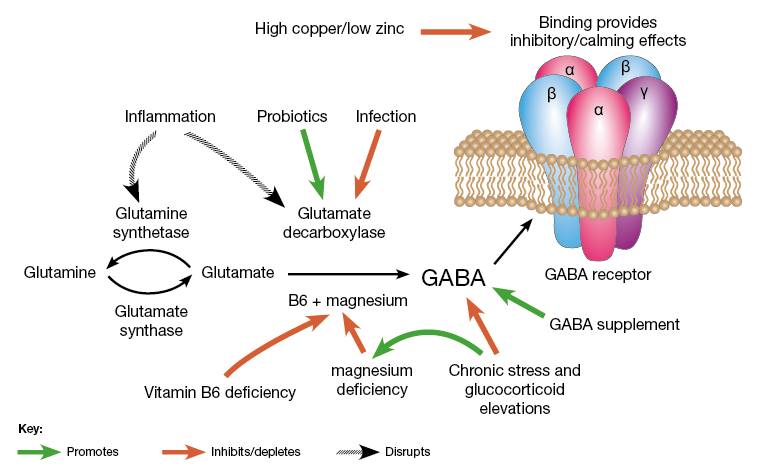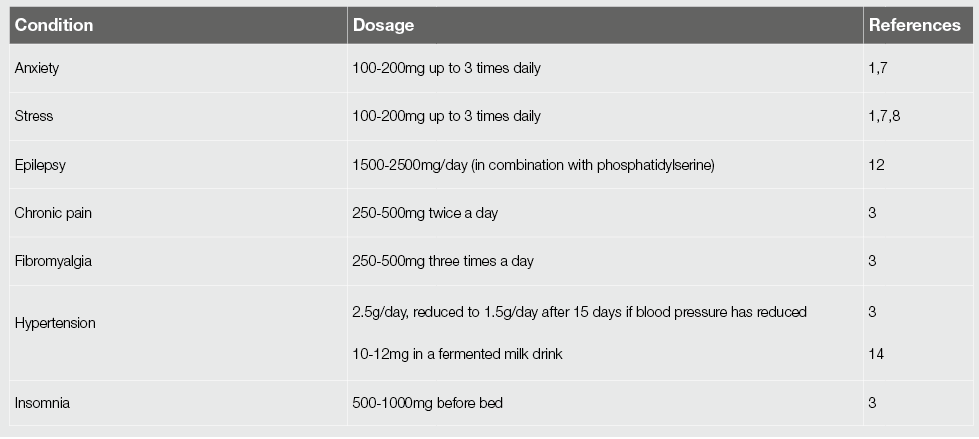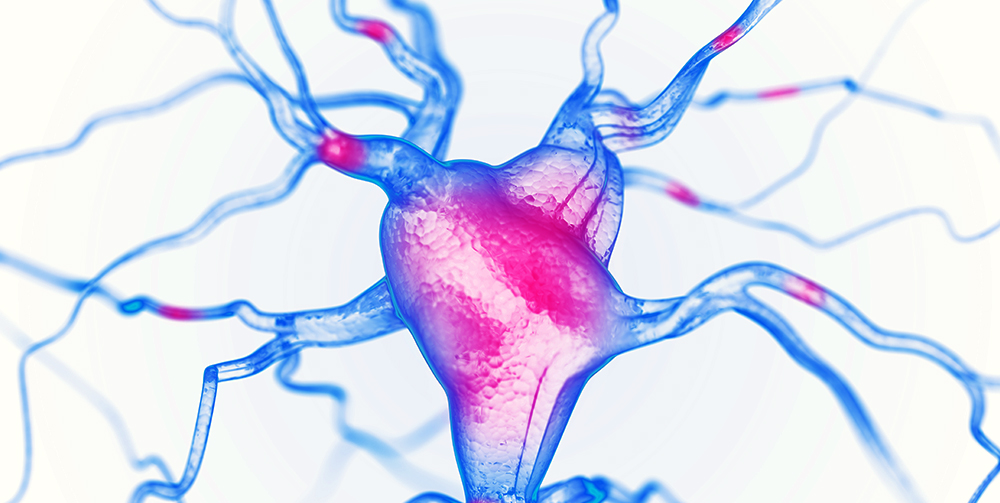Background
Gamma-aminobutyric acid (GABA) is widely distributed throughout the central nervous system (CNS) and is the major inhibitory neurotransmitter in the brain. Reduced GABA levels, or impaired GABA function, in the brain has been linked to psychiatric and neurological disorders including anxiety, depression, insomnia and epilepsy.[1]
Natural GABA supplements are produced via a fermentation process that utilises Lactobacillus hilgardii, a bacteria used in the fermentation of vegetables including the Korean dish kimchi.[1] As an oral supplement, GABA is used for anxiety, depression, stress, insomnia, premenstrual syndrome (PMS), epilepsy, stabilising blood pressure, addictions and attention deficit hyperactivity disorder (ADHD).[2]
Key benefits
- Antihypertensive
- Anti-stress
- Anxiolytic
- Major inhibitory neurotransmitter in the brain
- Relaxant
Clinical applications
- Anxiety
- Attention deficit hyperactivity disorder (ADHD)
- Drug and alcohol addiction
- Epilepsy
- Fibromyalgia and pain syndromes
- Insomnia and sleep difficulties
- Premenstrual syndrome (PMS)
- Stress
Mechanisms of action
GABA is synthesised in tissues from glutamic acid via the enzyme glutamic acid decarboxylase (GAD), with pyridoxal-5-phosphate (P5P) acting as a cofactor.[1]
Outside of the CNS, GABA is synthesised by the colonic microflora.[3] As the major inhibitory neurotransmitter, GABA counteracts over excitation in the brain, and has been described as acting like a ‘brake’ on the neuronal circuitry during times of increased stress.[4] Following its release from GABAergic nerve terminals, it acts on both GABAA and GABAB receptors, with a net inhibitory effect.[5]
The GABAA receptors regulate brain excitability and are responsible for GABA’s immediate synaptic inhibitory effects.[3] As low GABA levels are associated with anxiety, depression, insomnia and epilepsy, medications that target these GABA receptors have been developed. There are many pharmaceutical medications, alcohol and psychoactive drugs that produce their anxiolytic, analgesic, anticonvulsant, and sedative effects by modulating GABAA receptor activity or by blocking the reuptake of GABA by GABA transporter (GAT) proteins.[3]
In addition to its effect on the brain, high doses of GABA (5-10g single dose) have been shown to exert effects on the endocrine system, including increases in plasma growth hormone levels, although the clinical significance of these effects is currently unknown.[1]
Influences of GABA synthesis and function

Anxiety and mood disorders
Low GABA levels are associated with anxiety and mood disorders including depression. Medications that target the GABAA receptor have been used for anxiety and associated depression and mood disorders for several decades.
GABAA receptor deficits have been found in specific regions of the brain in patients with generalised anxiety disorder, panic attacks and post-traumatic stress disorder.[6] Similarly, research shows that patients with depression exhibit decreased brain concentrations of GABA and alterations in the GABAA receptors, with the most pronounced deficits found in patients with melancholic and treatment-resistant subtypes of depression.[6]
Clinical studies utilising GABA in supplemental form show that it induces relaxation, increases alpha brain waves, improves mood, reduces markers of stress and provides anxiolytic activity in both stressed and healthy subjects.[7,8] GABA supplementation appears to be fast acting, with the beneficial effects noticeable within 60 minutes.
Sleep disorders
Due to its effect on anxiety and relaxation, GABA shows potential for the treatment of sleep disorders including insomnia. GABAA receptors are concentrated in the thalamus, an area of the brain involved in sleep regulation.[9] Many sedative and hypnotic pharmaceutical medications target these GABAA receptors. A small, unpublished trial utilising 100mg of GABA found that it decreased sleep latency (time it takes to fall asleep) by 20%, while also increasing the time that individuals spent in deep sleep by the same percentage.[1]
Epilepsy
Proposed underlying mechanisms in the aetiology of epilepsy include neurotransmitter imbalances (including GABA deficiency), reduced inhibition of neuronal activity and structural changes affecting neuronal excitability.[10]
A large number of anti-epileptic medications exert their benefit through direct or indirect GABA enhancement, including increasing GABAergic inhibition, inhibiting GABA reuptake and increasing synaptic GABA concentrations.[1,11]
GABA, in combination in with phosphatidylserine (PS), has been used in clinical trials for the treatment of epileptic seizures. Preliminary research showed that a GABA-PS combination given in increasing doses to patients with drug-resistant epilepsy resulted in a significant, dose-dependent decrease in absence seizures, but not in simple or complex partial seizures.[12] Patients received 1500mg, 2000mg or 2500mg of GABA and 300mg, 400mg or 500mg of PS daily in increasing monthly increments for three months. Currently, GABA alone has not been shown to produce these favourable results, although further research is warranted.
Fibromyalgia and pain syndromes
It has been noted that GABA plays a critical role in pain transmission. Research suggests that lower concentrations of GABA resulting in decreased inhibitory transmission may play a role in the pathophysiology of fibromyalgia and other central pain syndromes. A clinical study revealed that patients with fibromyalgia were found to have significantly lower GABA levels in the right anterior insula compared with healthy controls.[13]
Clinical studies
GABA provides relaxant, anxiolytic and immune enhancing effects
Background: A two-part study to investigate the effects of GABA supplementation on relaxation and immunity during stress.
Subjects/Method: Study one involved 13 healthy participants who each completed 3 tests, 7 days apart. Brain waves were recorded via electroencephalograms (EEG) prior to receiving treatment, and again at 0, 30 and 60 minutes after administration of the treatment. Study two involved 8 participants with acrophobia (fear of heights) who crossed a suspended bridge, which was used as a stressful stimulus. Salivary secretary immunoglobulin (sIgA) levels (a marker of relaxation, stress and immune response) were measured before, during and at the completion of the bridge crossing.
Intervention: Study one participants received 200mL water in week one, 200mL water plus 100mg GABA in week 2 and 200mL water plus 200mg L-theanine in week 3. Study two participants received 200mg GABA or placebo prior to crossing the suspended bridge.
Results: In study one, GABA administration resulted in a significant increase in alpha brain waves, compared to the water or L-theanine, while also decreasing beta waves, indicating a relaxing and anxiolytic effect. In study two, participants receiving GABA experienced significantly higher salivary sIgA levels at the end of the bridge test, while participants receiving the placebo had lower sIgA levels at the end of the bridge test. The anxiolytic and relaxant effects of GABA were evident within 1 hour of administration and its use has the potential to enhance immunity under stressful conditions.
GABA reduces stress and improves mood during mental tasks
Background: To evaluate the psychological and physiological effects of GABA in humans under mental stress.
Subjects/Method: 63 adults (28 males, 35 females) participated in the single-blind, placebo-controlled, randomised crossover study over two experiment days. Participants undertook mental stress tests and completed Profile of Mood States (POMS). EEG recordings were used to analyse brain waves.
Intervention: 100mg GABA or placebo each day of the testing (2 days).
Results: EEG activities including alpha-band and beta-band brain waves decreased depending on the mental stress task loads, indicating that GABA alleviated stress induced by mental tasks. The results of the POMS indicated a mood-improving effect with GABA supplementation, which lasted up to 90 minutes after intake.
Imbalanced GABAergic synapses in autism
Background: GABA and glutamate are the main inhibitory and excitatory neurotransmitters in the human brain. This study aimed to elucidate the relationship between glutamatergic/GABAergic imbalance and neuro-inflammation in the aetiology of autism.
Subjects/Method: The plasma levels of glutamate, GABA and glutamate/GABA ratio as markers of excitotoxicity together with tumour necrosis factor-alpha (TNF-alpha), interleukin (IL)-6, interferon gamma (IFN-gamma) and interferon gamma-inducible protein (IFI16) as markers of neuro-inflammation were determined in 20 autistic patients and 19 gender-matched healthy controls.
Results: Analysis of the results revealed associations between reduced GABA levels, neuroinflammation and glutamate excitotoxicity. The results indicate that autism is a developmental synaptic disorder characterised by an imbalance in GABAergic and glutamatergic synapses due to neuroinflammation.
Dosage range according to clinical studies

Cautions and contraindications
- Not recommended during pregnancy or lactation.[1]
- GABA may decrease blood pressure in hypertensive individuals. Theoretically, concomitant use of GABA and antihypertensive medications may result in hypotension.[2]
- Use with caution in patients taking synthetic GABA agonist medications or herbs that interact with the GABAergic system (e.g. Valeriana officinalis, Hypericum perforatum). If additional sedative/relaxant effects are required, start GABA supplementation slowly and at a low dose.
- Unlike synthetic GABA-agonist drugs, natural GABA is virtually without side effects.[1]
References
- Gamma-aminobutyric acid (GABA). Altern Med Rev 2007;12(3):274-279. [PDF]
- GABA (Gamma-aminobutyric acid). Natural Medicine Comprehensive Database 2015. Viewed 8 Oct 2015, www.naturaldatabase.com
- GABA. Natural Medicines monograph 2014. Viewed 10 Oct 2015, https://naturalmedicines.therapeuticresearch.com/
- Weeks BS. Formulations of dietary supplements and herbal extracts for relaxation and anxiolytic action: Relarian. Med Sci Monit 2009;15(11):RA256-62. [Abstract]
- Sills GJ. Mechanisms of action of antiepileptic drugs. Epilepsy Society 2013. Viewed 12 Oct 2015, http://www.epilepsysociety.org.uk/sites/default/files/attachments/Chapter25Sills.pdf
- Luscher B, Shen Q, Sahir N. The GABAergic deficit hypothesis of major depressive disorder. Mol Psychiatry 2011;16(4):383-406. [Full text]
- Abdou AM, Higashiguchi S, Horie K, et al. Relaxation and immunity enhancement effects of gamma-aminobutyric acid (GABA) administration in humans. Biofactors 2006;26(3):201-208. [Abstract]
- Yoto A, Murao S, Motoki M, et al. Oral intake of γ-aminobutyric acid affects mood and activities of central nervous system during stressed condition induced by mental tasks. Amino Acids 2012;43(3):1331-1337. [Abstract]
- Orser BA. Extrasynaptic GABAA receptors are critical targets for sedative-hypnotic drugs. J Clin Sleep Med 2006;2(2):S12-18. [Abstract]
- Bautista C. Disorders of brain function. In: Grossman SC, Porth CM. Porth’s pathophysiology: concepts of altered health states, 9th ed (pp.489-524). Philadelphia: Walters Kluwer Health | Lippincott Williams & Wilkins, 2014.
- Czapinski P, Blaszczyk B, Czuczwar SJ. Mechanisms of action of antiepileptic drugs. Curr Top Med Chem 2005;5(1):3-14. [Abstract]
- Loeb C, Benassi E, Bo GP, et al. Preliminary evaluation of the effect of GABA and phosphatidylserine in epileptic patients. Epilepsy Res 1987;1(3):209-212. [Abstract]
- Foerster BR, Petrou M, Edden RA, et al. Reduced insular y-aminobutyric acid in fibromyalgia. Arthritis Rheum 2012;64(2):579-583. [Full text]
- Inoue K, Shirai T, Ochiai H, et al. Blood-pressure-lowering effect of a novel fermented milk containing gamma-aminobutyric acid (GABA) in mild hypertensives. Eur J Clin Nutr 2003;57(3):490-495. [Full text]
DISCLAIMER:
The information provided on FX Medicine is for educational and informational purposes only. The information provided on this site is not, nor is it intended to be, a substitute for professional advice or care. Please seek the advice of a qualified health care professional in the event something you have read here raises questions or concerns regarding your health.


